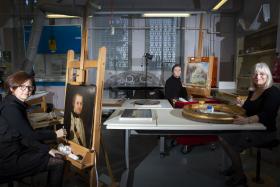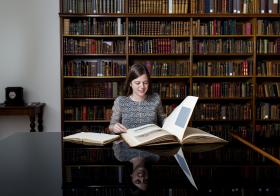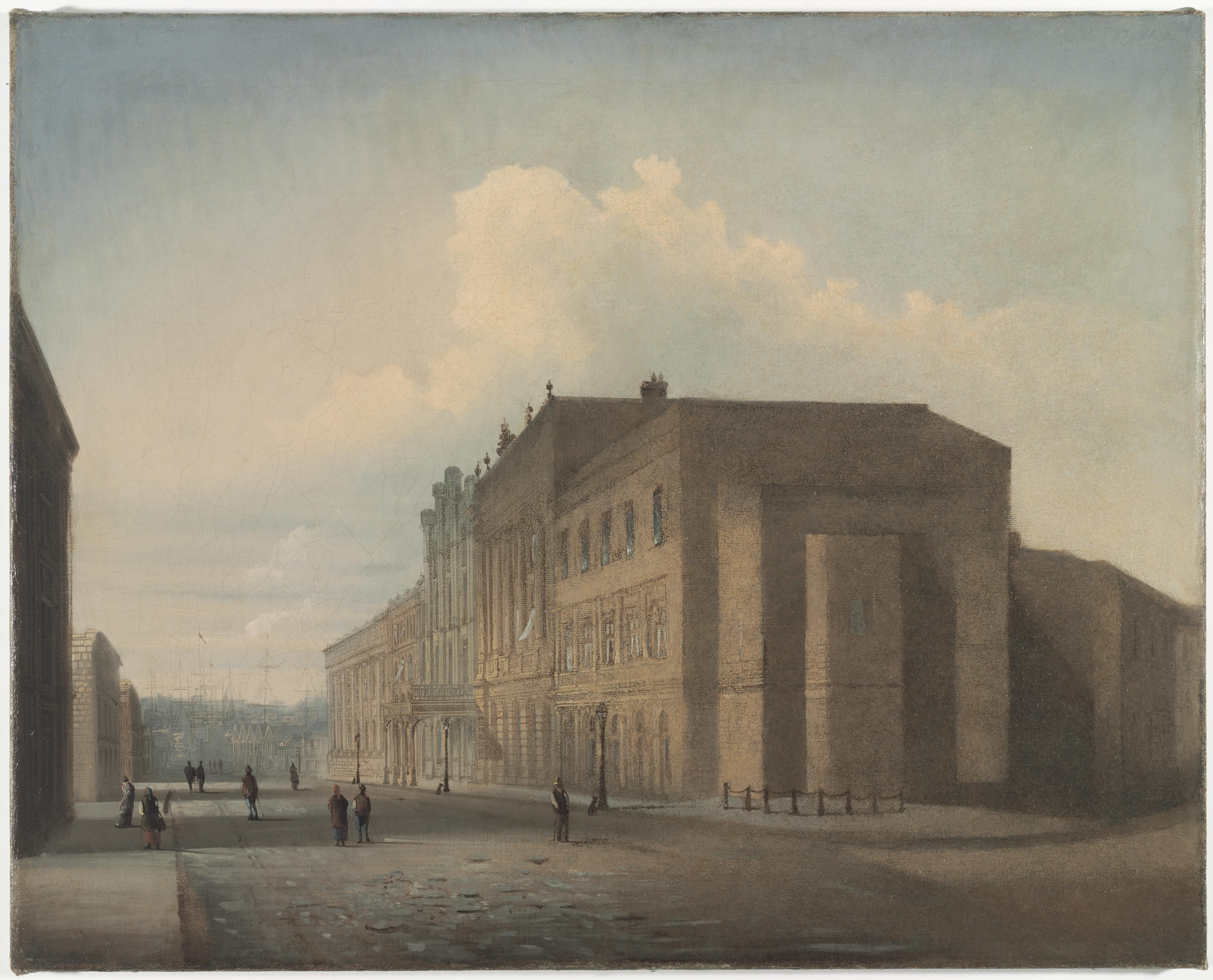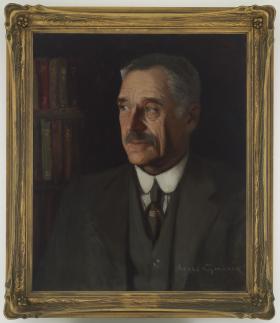 On 31 May 2018, Library photographer Joy Lai ‘spent an afternoon bouncing light around an incredible portrait of Māori Chief Te Hapuku, painted by Gottfried Lindauer in 1877’. Te Hapuku was the leader of Ngāti Te Whatuiāpiti, in New Zealand’s Hawke’s Bay region, and the painting shows him in full ceremonial dress.
On 31 May 2018, Library photographer Joy Lai ‘spent an afternoon bouncing light around an incredible portrait of Māori Chief Te Hapuku, painted by Gottfried Lindauer in 1877’. Te Hapuku was the leader of Ngāti Te Whatuiāpiti, in New Zealand’s Hawke’s Bay region, and the painting shows him in full ceremonial dress.
Joy set up her lights to allow the oil painting’s natural sheen to show through in her photographs. She researched other paintings by Lindauer to see how major art galleries had digitised his work. But it was the subject of the painting that made the strongest impression on her. ‘Great to hang with another Kiwi at work,’ she posted on social media, ‘We didn’t talk about the rugby once!’
The portrait of Chief Te Hapuku is one of 301 artworks, many leaving basement storage for the first time in decades, now on permanent display in the Paintings from the Collection exhibition in the Library’s refurbished Mitchell and Dixson Galleries. The new Collectors’ Gallery, off the Mitchell Library Reading Room, houses hundreds of objects — from coins and teaspoons to larger ceramic and metal artefacts, some dating to the early days of the colony.
Four temporary exhibitions also opened on 6 October 2018: Sydney Elders: Continuing Aboriginal Stories, guest-curated by Wiradjuri Kamilaroi artist Jonathan Jones; UNESCO Six, showcasing our collections listed on the UNESCO Memory of the World register; Memories on Glass: The Macpherson Family Collection; and #NewSelfWales, which combines State Library and crowdsourced portraits.


Stretching across the first floor of the Mitchell Building, the expanded exhibition spaces make it possible to display more of the six million items in the Library’s collection. ‘It demonstrates that we are more than collectors of books and manuscripts,’ says Rawiya.
UNESCO Six brings together our world-heritage collections: First Fleet journals, First World War diaries, a poetry notebook of Dorothea Mackellar, papers of ‘enemy aliens’ interned in Australia from 1914 to 1919 and the Holtermann Collection of photographs, including the world’s largest glass-plate negatives (measuring up to 1.5 metres in width).
As this exhibition is in a large new gallery that was once a staff area, exhibition designer Paul Bewley had the challenge of placing objects and graphics in a space that hadn’t been used in this way before. Paul produced a three-dimensional model to examine how exhibition visitors would encounter the space. He had to consider lighting and acoustics, while coming up with an exhibition design that flows around the gallery’s many columns.
Sydney Elders documents the living memory of four Indigenous elders, with video interviews, photographs and documents from the collection. The installation features display panels leaning against the gallery’s walls: ‘They play on the relationship between Aboriginal people and the knowledge housed and displayed within western institutions,’ according to Jonathan Jones. ‘But they also celebrate the alternative ways Aboriginal people live and engage with space.’
In preparing for Memories on Glass — showcasing a selection of the century-old glass-plate negatives donated by the Macpherson family in 2014 — curator Margot Riley came up against a lack of information about these images of street scenes, beaches and trips to popular leisure spots in the early twentieth century. ‘Very few of the people or places recorded in the images were described,’ says Margot.
A remedy was found in the expertise of the online community. A selection of images was uploaded to the Library’s Flickr page, attracting the attention of ‘digital volunteers’ who quickly generated information about the locations.
Some images in the Macpherson collection needed extra sleuthing, such as a photograph of people walking along a path above a rocky shoreline scattered with enormous bones.
‘At first I thought the image may have been taken overseas,’ says Margot, ‘documenting an archaeological excavation and the pre-historic remains of either a dinosaur or a mammoth. But, using a magnifying glass, I noticed the women in the group were holding handkerchiefs to their noses. That’s when I realised, if there was still a bad smell in the air, then these giant skeletal remains must be more recent.’ Looking at the topography of sheer cliffs rising out of the sea and the pine trees, Margot suspected this could be the whaling station at Cascade Bay on Norfolk Island. An online image search produced a perfect match.
As part of the team of curators preparing for the paintings exhibition, Anna Corkhill had to find a date for a painting of the corner Pitt and Spring streets, Sydney. She identified the location with help of Google maps, then looked at architectural features. One of the main buildings — the headquarters of the Australian Mutual Provident Society — was constructed in 1864. Searching through newspaper articles and documents on the Trove website, Anna found that the statue on top of the building was moved to the society’s new premises on the corner of Pitt and Bent streets in 1880. As the statue is visible in the painting, she was able to give it a date between 1864 and 1880.
To earn a place in the Paintings from the Collection exhibition, artworks had to pass the vigorous assessment of the Library’s Collection Care team. Many stunning and significant paintings were found to be in need of conservation treatment due to tears, cracking, missing or damaged frames and other problems predating their time in the Library. Conservators need to separate a frame from its canvas for cleaning and photography; conservators with different specialisations treat the frame and the painting.
The ‘Sponsor a Painting’ campaign, run by the Library’s Foundation, offered members of the public a chance to choose an artwork that appealed to them and support its preparation for exhibition. ‘The campaign generated more interest and passion than any of us expected,’ says Foundation Director Susan Hunt. ‘People have been excited to explore the website and choose works which have personal significance. I’ve heard wonderful stories about paintings that show a place associated with their family, a portrait of a person they admire, or a town they grew up in.’
A painting that stands out for Anna Corkhill is a portrait of Banjo Paterson by Agnes Noyes Goodsir, an artist who flourished in the 1920s but was ‘virtually unknown until an exhibition of her paintings at the Ballarat Art Gallery in Victoria in the late 1990s brought her work to the surface’.
Goodsir spent most of her career in Paris, but returned to Australia for one year in 1927 when the Paterson portrait was commissioned by Eadith Campbell Walker. The painting’s provenance was established through a combination of newspaper research and the Library’s acquisitions committee minute books.
‘The lines of Paterson’s face are quite pronounced in this portrait,’ says Anna, ‘which was painted when Paterson and Goodsir were both 63 years old. I wonder if her emphasis on the age lines in his face reflects the artist’s own understanding of their mutual stage of life.’
Cathy Perkins
Editor, SL magazine
The Library’s new Michael Crouch Family Galleries opened on 6 October 2018.


